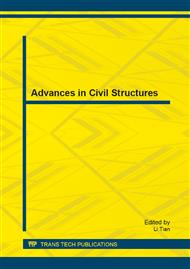[1]
N XU, X L GU, Q H Huang, W P Zhang. Study Method of Environmental Action for Concrete Structures [J]. Structural Engineers, 2010, 26 (2): 166-171. (in Chinese).
Google Scholar
[2]
M Lu. Durability-assessment-based Residual Service Life Predication of Existing R. C. structures [J]. Building Science, 1999, 15(2): 25-30. (in Chinese).
Google Scholar
[3]
J Zhu, Robust regression. Analysis of The Durability of Concrete Structure [J]. Concrete, 2012, 33(8): 46-48. (in Chinese).
Google Scholar
[4]
S L Chen. Mechanism Influencing Factors and Forecasting Models of Concrete Carbonation [J]. Journal of North China Institute of Water Conservancy and Hydroelectric Power, 2010, 31(3): 37- 41. (in Chinese).
Google Scholar
[5]
F W Liang. Durability Study of Large-scale Reinforced Concrete Piled Wharf [J]. Port & Waterway Engineering, 2002, (12), 23-26. (in Chinese).
Google Scholar
[6]
J. E. Bennett, T. J. Shue. Galvanic Cathodic Protection of Reinforced Concrete Bridge Members Using Sacrificial Anodes Attached by Conductive Adhesives [R]. FHWA-RD-96-073, Federal Highway Administration. Washington DC, (1996).
Google Scholar
[7]
J. R. Clifton. Predicting the Service Life of Concrete [J]. ACI Material Journal, 1993, 90(6): 611- 617.
Google Scholar
[8]
H F Yu, W Sun. Study on Prediction of Concrete Service Life-theoretical Model [J]. Journal of the Chinese Ceramic Society, 2002, 30(6): 686-690. (in Chinese).
Google Scholar
[9]
M. Funahashi. Predicting Corrosion-free Service Life of Concrete Structure in Chloride Environment [J]. ACI Materials Journal, 1990, 87(6): 581- 587.
DOI: 10.14359/2533
Google Scholar
[10]
Z. P. Bažant. Physical Model for Steel Corrosion in Concrete Sea Structures-theory [J]. Journal of the Structural Division, 1979 (6): 1137-1153.
DOI: 10.1061/jsdeag.0005168
Google Scholar
[11]
Z. P. Bažant. Physical Model for Steel Corrosion in Concrete Sea Structures-application [J]. Journal of the Structural Division, 1979(6): 1155-1166.
DOI: 10.1061/jsdeag.0005169
Google Scholar
[12]
D T Niu, Q L Wang, L K Wang. Corrosion Prediction Model before Corrosion Cracking in Concrete Structure [J]. Industrial Building, 1996, 26(4): 8-10. (in Chinese).
Google Scholar
[13]
W L Jin, Yan F, L Zhang. Corrosion Rate Prediction Model Considering the Concrete Carbonation Regular [J]. Journal of Zhejiang University, 2000, 34(2): 430-434. (in Chinese).
Google Scholar
[14]
Y L Hui. Experimental Study of the Assessment and Prediction of the Extent of Corrosion in Concrete Structures [J]. Industrial Building, 1997, 27(6): 6-9. (in Chinese).
Google Scholar
[15]
S. F. Daily. Galvanic Cathodic Protection of Reinforced and Prestressed Concrete using a Thermally Sprayed Aluminum Coating [J]. Concrete Repair Bulletin, 2003, 16(4): 12-15.
Google Scholar
[16]
Q Wu, Y S Yuan, J Y Li. Research on Structural Behavior's Deterioration of Corroded Reinforced Concrete Beams under Man-made Climate [J]. Journal of China University of Mining & Technology, 2007, 36(4): 441-445. (in Chinese).
Google Scholar
[17]
N Xu, W P Zhang, X L Gu, Q H Huang. Spatial Multi-scale Environmental Actions for Concrete Structures [J]. Journal of Tongji University, 2012, 40(2): 159-166. (in Chinese).
Google Scholar
[18]
N Xia, X M Yu, W Q Ren. Current Situation of Research on durability of Concrete Structures [J]. Advances in Science and Technology of Water Resources, 2005, 25(4): 63-70. (in Chinese).
Google Scholar
[19]
X C Wang, M J Jin, C F Yang. Reliability of Concrete Structure [J]. Concrete, 2006, 27(2): 31-33. (in Chinese).
Google Scholar


